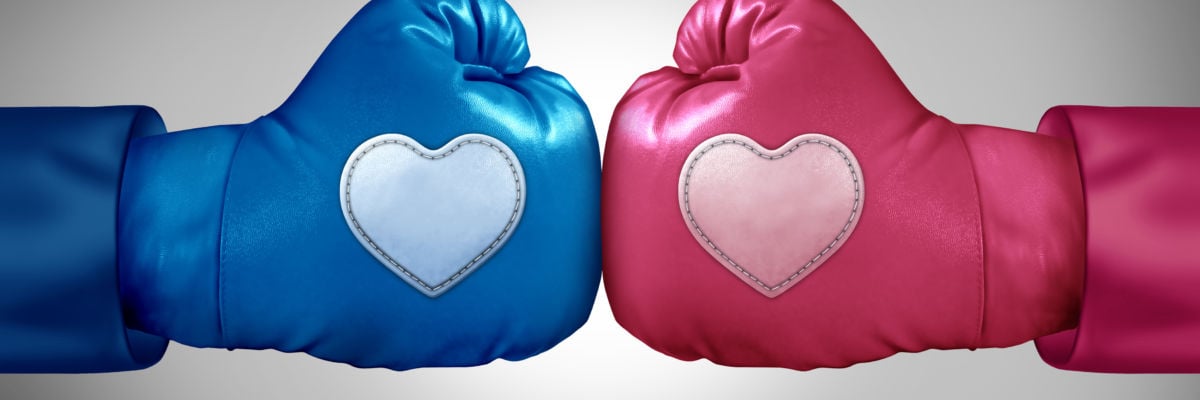
It’s long been a hot topic to discuss the similarities and differences between men and women—with little apparent agreement as to what are or are not universally recognized similarities and differences. But the “battle of the sexes” is miscast. The real issue, so often overlooked, is that men and women are equally human, yet not interchangeable.
Any discussion about the natures of men and women requires doing what is forbidden in our age: making generalizations, even referencing stereotypes. Men and women generally exhibit collective features, which doesn’t mean that there are no exceptions, but societies function on the basis of the rule, not the exception.
We have a tendency to view any recognition of one sex’s strengths as the other sex’s weakness, but doing so prevents an objective approach to the complementary nature of our creation.
To point to men’s obvious physical advantages is not to say that women are less than men—because that would be to hold women to a false standard (men’s). We must not fall for the modern error of seeing the perfect woman as a man. Nor is it pointing at male failure or inadequacy versus women to say that women are inherently more nurturing—for the ideal man is not a woman.
The modern desire to eliminate differences between the sexes is to reduce people to androgynous objects that can only aim at an ideal that they were not made for. It’s the product of trying to take complementary sexes that were obviously made for each other and deprive them of their Creator, and thus their purpose and their beauty.
Despite the attempts at recreating us as androgynous creatures, we are quite different in a lot of ways. Our physical disparities are the most obvious to anyone who has engaged in any strength-based exercise with someone of the opposite sex, but we even think differently.
Women are more prone to discussing the personal. They want to know whether the opinion that you hold is a result of some unspoken experience, a deeply rooted trauma, or an attachment to a moment of joy, as well as how it might affect your decision-making in the future. They want to know what you feel and why. Most will then happily share and draw parallels from their own experiences. This is how they bond, forming friendships that are deeply emotional and personal.
Men tend to think in more abstract terms, divorcing themselves from the topic they are discussing. The project becomes the focus of attention, not their affections toward it or what it might remind them of. Men seem to create the closest bonds when they join to conquer a project—as a platoon, a group of builders, amateur hunters, etc. It’s the urge of conquest and shared victory that make brothers-in-arms.
Although it’s tempting for us to put these two “thinking methods” against each other, both approaches have their proper application and provide regulation against the harmful excesses of the other. A man’s wife can be invaluable when she calls him to reassess his motivation for an action that he had falsely considered an impersonal judgment. A woman’s husband can help her to see beyond her pain and toward a larger picture when she’s too close to a situation to view it objectively.
When tragedies happen, women are likely to fall into a supportive role, driven to help the weakest and most vulnerable. Even when the event is minor, women rush to provide emotional support to the person who is discouraged.
Men are the problem-solvers. It is the frustration of many a wife that when she begins venting to her husband about what distresses her, he immediately presents solutions instead of joining her in her distress. He is thus interpreted as being unempathetic or, worse, “not loving.” Yet he shows that he loves her by fixing what ails her.
When we deny these roles, we get inferior versions of both sexes and a society that is less than it could be.
When women aspire to be the sexless creature of modernity, they often present with an over-compensatory aggression. They deny all of their femininity and pretend to think and be as men. They are the modern feminists who hate men, in part for having features they cannot quite attain, such as masculine strength.
When men aim for the same sexless creature, they grow effeminate, reaching neither the masculine that they deny nor the feminine, instead stunted at a juvenile state of emotionalism.
Those wrapped in contest between the sexes only do further harm. Just as feminists create more reasons for men to distrust women, many men who falsely claim to be “traditionalist” see women as objects to dominate, thus creating more feminists. It’s the consequence of a rage-induced tunnel vision that tragically denies the beautiful truth of men and women created as distinct and complementary. We were made for each other.
The chatter about the so-called “gender war” misdirects our attention because it is dominated by secular voices. They cannot see that the sexes provide the perfect complement, because that would provide evidence for a Creator. Our union could not be by mere chance, because it is perfect. When men and women work together, their thinking is balanced, between the abstract and the personal, the logical and the emotional, presenting compassionate solutions in the home and beyond.



